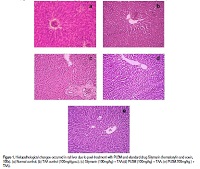Curative effect of Plumbago indica root extract on thioacetamide induced hepatotoxicity in experimental rats
Keywords:
Plumbago indica, antioxidant, hepatotoxicity, curative effect, oxidative stress, thioacetamideAbstract
The root parts of Plumbago indica is widely used in the Indian Ayurvedic traditional system. The study was designed to evaluate the hepato curative activity Plumbago Indica (PLBM) methanolic root extracts at different doses (100 and 200 mg/kg bw) against thioacetamide induced liver damage in albino wistar rats. Liver damage was induced by administration of Thioacetamide (100 mg/kg bw) and was assessed by evaluating the activity of liver-function marker enzymes, antioxidant enzymes and lipid peroxidation. The liver sections were evaluated for histopathological changes. PLBM significantly (p ≤ 0.05) reversed the elevation of serum liver enzymes and hepatic levels of antioxidant markers. Histopathological findings also confirmed the curative effect of Plumbago Indica in a dose dependent manner. Thus this study scientifically rationale the use of Plumbago indica root as a promising drug against various liver disorders.
References
Loguercio C, Federico A. Oxidative stress in viral alcoholic hepatitis. Free Radic Biol Med. 2003; 34:1-10.
Vitaglione P, Morisco F, Caporaso N, Fogliano V. Dietary antioxidant compounds and liver health. Crit Rev Food Sci Nutr.2004; 44:575-586.
Bhathal PS, Rose NR, Mackay IR, Whittingham S. Strain difference in mice in Carbon tetrachloride-induced liver injury. Br J Exp Pathol.1983; 4: 524-33.
Tawaha K, Alali FQ, Gharaibeh M, Mohammad M, Tamam El-Elimat. Antioxidant activity and total phenolics content of selected Jordanian plant species. Food Chem. 2007; 104: 1372-78.
Subhasree B, Baskar R, Laxmi KR, Lijina SR, Rajesekaran P. Evaluation of antioxidant potential in selected green leafy vegetables. Food Chem. 2009; 115:1213-1220.
Chandrasekara A, Shahidi F. Inhibiting activities of soluble and bound millet seed phenolics on free radicals and reactive oxygen species. J Agri Food Chem. 2011; 59: 428- 436.
Rajkumar V, Guha G, Kumar RA, Mathew L. Evaluation of antioxidant activities of Bergenia ciliate rhizome. Rec Nat Prod. 2010; 4: 38-48.
Venkateswaran S, Pari L, Viswanathan P, Menon VP. Protective effect of livex, a herbal formulation against erythromycin estolate-induced hepatotoxicity in rats. J Ethnopharmacol.1997; 57: 161-7.
Shyamal S, Latha PG, Suja SR, Shinev J, Anuja GI, Sini S. Hepatoprotective effect of three herbal extracts on aflatoxin B1-intoxicated rat liver. Sing Med J. 2010; 51: 326-331.
De paiva SR, Fugueiredo MR, Aragao TV, Kaplan MA. Antimicrobial activity invitro of plumbagin isolated from Plumbago species. Mem Inst Oswaldo Cruz 2003; 98:959-961.
Valsaraj R, Pushpangadan P. Antimicrobial screening of selected medicinal plants from India. J Ethnopharmacol. 1997; 58:75-83.
DE paiva SR, Marques SS, Figueiredo MR, Kaplan MAC. Plumbaginales Floresta e Ambiente. 2003; 10:98-105.
Sheeja E, Joshi SB. Antifertility activity of stem of P. rosea in female albino rats. Pharm Biol. 2008; 46: 920-927.
Nguyen AT, Malonne H, Duez P, Vanhaelen-Fastre R, Vanhaelen M, Fontaine J. Cytotoxic constituents from Plumbago zeylanica. Fitoterapia. 2004; 75: 500-504.
Eldhose B, Notario V, Kuriakose J, Latha MS. Hepatoprotective effect of Plumbago indica root extract on thioacetamide induced liver damage in rats. J Pharm and Phyt. 2015; 4: 113- 117.
Shymal S, Latha PG, Suja SR, Shine VJ, Anuja GI, Sini S. Hepatoprotective effect of three herbal extract on aflatoxin B1-intoxicated rat liver. Singapore Med J. 2010; 51: 326-331.
Beers RF Jr, Sizer IW. A spectrophotometric method for measuring the breakdown of hydrogen peroxide by catalase. J Biol Chem. 1952; 195:133-140.
Rotruck JT, Pope AL, Ganther HE, Swanson AB, Hafeman DG, Hoekstra WG. Selenium: Biochemical role as a component of glutathione peroxidase. Science.1973; 179:588–590.
Habig WH, Pabst MJ, Jakoby WB. Glutathione S-transferase. The first enzymatic step in mercapturic acid formation. J Biol Chem. 1974; 249: 7130-7139.
Ellman GL. Tissue sulfhydryl groups. Arch Biochem Biophys. 1959; 82: 70-77.
Niehaus WG, Samuelsson B. Formation of malonaldehyde from phospholipid arachidonate during microsomal lipid peroxidation. Eur J Biochem.1968; 6:126-130.
Lefkowitch JH. Pathologic diagnosis of liver diseases. In: Zakim D, Boyer TD: Hepatology. (Ed 3) WB Saunders, Philadelphia, 1996, 844-874
Shapiro H, Ashkenazi M, Weizman N, Shahmurov M, Aeed H, Bruck R. Curcumin ameliorates acute thioacetamide-induced hepatotoxicity. J Gastroenterol Hepatol. 2006; 21: 358-366.
Ambrose AM, DeEds F, Rather LJ. Further studies on toxicity of thioacetamide in rats. Proceedings of Society of Experimental and Biological Medicine. 1950; 74: 134–140.
Loguercio C, Federico A. Oxidative stress in viral alcoholic hepatitis. Free Radic Biol Med. 2003; 34:1-10.
Manna P, Sinha M, Pal P, Sil CS. Arjunolic acid, a triterpenoid saponin, ameliorates arsenic-induced cyto-toxicity in hepatocytes. Chem Biol Int. 2007; 170: 187-200.
James M, May, Zhi- Chao QU, Richard R, Whitesell. Ascorbic acid recycling enhances the antioxidants reserve of human erythrocytes. Biochemistry. 1995; 34: 121-28.
Ansil PN, Nitha A, Prabha SP, Wills PJ, Jazaira V, Latha MS. Protective effect of Amorphophallus campanulatus (Roxb.) Blume.tuber against thioacetamide induced Oxidative stress in rats. Asian Pac J Trop Med. 2011; 4:870-877.
Carlberg I, Mannervik B. Glutathione reductase. Methods Enzymol. 1985. 113: 484-90.
Hodgson EK, Fridovich I. The interaction of bovine erythrocyte superoxide dismutase with hydrogen peroxide, Chemiluminescence and peroxidation. Biochemistry.1995; 14: 5299- 303
Comporti M. Lipid peroxidation and cellular damage in toxic liver injury. Lab Invest. 1985; 53:599-603.



